The very first Pinoy komiks superheroes appeared in 1946, right at the birth of the Philippine comics industry. Incidentally, that year also marked the independence of the Philippines from the United States, after surviving the destructive three-year Japanese Occupation.
After the war, a few enterprising individuals started the very first komiks-magazines in the Philippines: Halakhak Komiks and Pilipino Komiks. Although Halakhak Komiks did not contain any serious superhero story, it had, on the other hand, a Pinoy funny superhero called Siopawman, created by a young cartoonist named Larry Alcala.
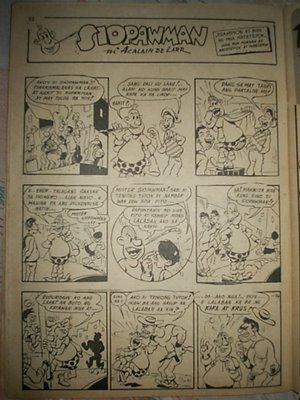 Siopawman by Larry Alcala may be the first, albeit fumbling, Pinoy komiks superhero.
Siopawman by Larry Alcala may be the first, albeit fumbling, Pinoy komiks superhero.
IPO-IPOThe first true Pinoy komiks superhero was Ipo-ipo, a character created by Lib Abrena and Oscar del Rosario in 1946 in a Tagalog magazine called Magasin ng Pagsilang.
Ipo-Ipo is an interesting character, he gets his superpowers from the whirlwind. He acquires the speed of the wind and bullets fired into him just pass through his body.
Fresh from the horrors of the Japanese invasion, Abrena and Del Rosario pitted Ipo-ipo against the ruthless Japanese soldiers who refused to surrender, even after the unconditional capitulation of Japan in 1945.
 Ipo-Ipo, the very first true Pinoy superhero: how can you beat a superhero that you cannot hit?
Ipo-Ipo, the very first true Pinoy superhero: how can you beat a superhero that you cannot hit?
LAGIM
Lagim first appeared in Pilipino Komiks #1 in 1947, created by Cris Caguintuan. Like Ipo-ipo, Lagim battles the Japanese forces who would not surrender. Lagim gets his power from a headgear given to him by a scientist named Dr. Malasakit. The headgear makes Lagim's strength twice that of a man. Unlike Ipo-ipo, Lagim is vulnerable, he could be hit by bullets. Yet, luck and his double-strength was enough to defend people from the evil forces.
He later saved a boy named Levy who became his sidekick.  Possibly influenced by Batman, Lagim even had a sidekick named Levy, whose costume was similar to Robin.
Possibly influenced by Batman, Lagim even had a sidekick named Levy, whose costume was similar to Robin.
VARGA
In July of 1947, Mars Ravelo created Varga in Bulaklak Maazine. Varga was actually the first Darna, and she also had an alter-ego named Narda. When Ravelo left Bulaklak and was hired in Ace Publications, he re-created Varga and renamed her Darna. Yes, the original Darna was named Varga
Yes, the original Darna was named Varga
In 1950, Darna appeared in Pilipino Komiks, re-created by Mars Ravelo and superbly illustrated by Nestor Redondo. The first story of Darna tells of her battles against the evil Valentina.
A TRADITION OF PINOY KOMIKS SUPERHEROES
More than any other superhero, Darna opened the floodgates of superhero stuff in Philippine comics. Aside from being the first komiks superhero to capture the attention of Pinoy komiks readers, Darna also lay claim as the first superhero to appear in the movies, with Rosa del Rosario in the lead role.
Indeed, throughout the years, Darna's commercial appeal proved her ultimate strength. In the 1970s, there were more movies about her, the top female stars of Philippine movies personifying her like Vilma Santos, Liza Moreno,Anjanette Abayari, to name a few. In mid-1970s, there was even a komiks named solely after her:Darna Komiks.
ENTER CAPTAIN BARBELL
Captain Barbell is another creation of Mars Ravelo, suited for the masculine readers of his komiks. Captain Barbell first appeared in Pinoy Komiks in 1963, and was superbly illustrated by Jim Fernandez. 
Captain Barbell Versus Captain Bakal, Pinoy Komiks 1964
Like Darna, Captain Barbell also had an alter-ego named "Tenteng", who is socially disavantaged,i.e., poor, and not very good looking. In the beginning issues of the komiks series, we see Tenteng being maligned by people above his social class, rejected by the woman he loves because he was ugly.
In a society in which the poor outnumbers the rich, Captain Barbell struck a chord among Pinoy komiks readers. Finally, here is a superhero whom they can identify with. Someone whose kindness at heart had blessed him with a superpower, the superior strength and the ability to fly, to help those who are poor and dowtrodden.
Captain Barbell also had his fair share in the movies; his character was personified in the screen by Dolphy, Bob Soler, Herbert Bautista, Edu Manzano, Bong Revilla, and Richard Gutierrez, being the latest.
MARS RAVELO: A KOMIKS SUPERHERO
More than any other komiks writer, it was Mars Ravelo who entrenched the tradition of superheroes in Philippine komiks. He had created more superheroes than any other Filipino comics writer. Yet, one can see that most of his superheroes were rooted from the poor and the disadvantaged, yet gifted with the values that are truly Filipinos. His superheroes are humans too, after all, they have their weaknesses, their human traits, and most of all compassion even for their enemies.
Why would Mars Ravelo concentrate so much on superheroes whose alter-egos are poor and downtrodden? Perhaps the answer lies within his own personal experiences. Mars grew up poor in a poor society. He tells of his experiences that he was so poor he was barely able to go to school. He never finished schooling though. "My teachers never liked me", he said, "And I never liked my teachers".
His first job was a janitor. Ravelo said "In everything I do I wanted to be #1, and when I became a janitor, well, I wanted to become the number 1 janitor"
Well, he did. It was in his personality to give his best in his every endeavor. And so, when he became a komiks writer, he was damned the best among them. Wether it was superhero stuff like Darna, or comedy like Buhay Pilipino, or heavy drama like Roberta, Ravelo was peerless.
I think Ravelo can truly personify his superheroes. He had lived like one.
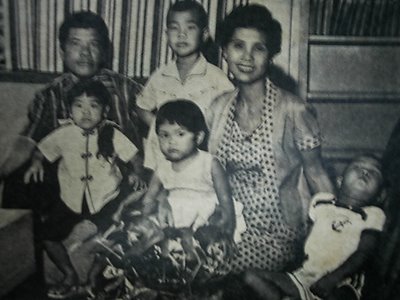 Mang Mars with wife and kids. Circa 1960s.
Mang Mars with wife and kids. Circa 1960s.  A barefooted Mars Ravelo, with two of his children, walking towards his fish pens in Cavite. Circa 1960s.
A barefooted Mars Ravelo, with two of his children, walking towards his fish pens in Cavite. Circa 1960s.
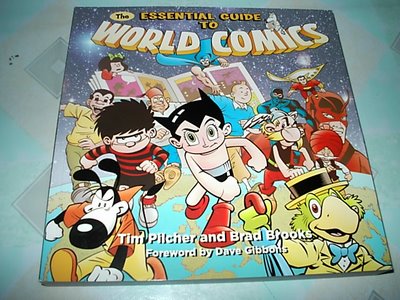
 A special two-page spread tribute to Tony Velasquez, father of Philippine Comics.
A special two-page spread tribute to Tony Velasquez, father of Philippine Comics.
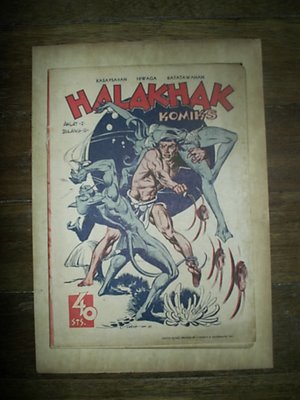 Halakhak Komiks #9, 1946. This is the only Coching cover for the extremely rare Halakhak Komiks, featuring Bulalakaw, one of his early komiks characters.
Halakhak Komiks #9, 1946. This is the only Coching cover for the extremely rare Halakhak Komiks, featuring Bulalakaw, one of his early komiks characters. Liwayway Cover, Issue for October 9, 1947
Liwayway Cover, Issue for October 9, 1947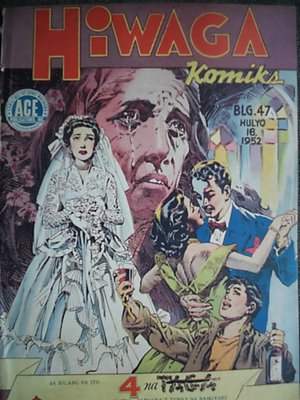 Hiwaga Komiks#47, July 16, 1952
Hiwaga Komiks#47, July 16, 1952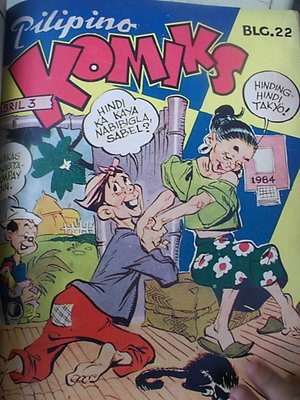
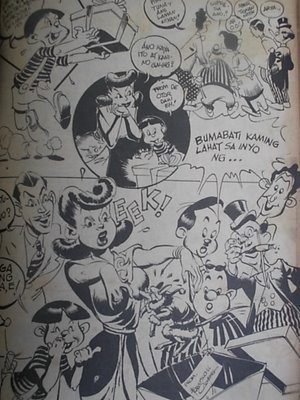 Paloma, the first cartoon character of Coching in Pilipino Komiks, 1947.
Paloma, the first cartoon character of Coching in Pilipino Komiks, 1947.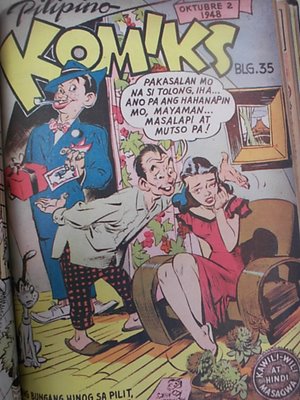

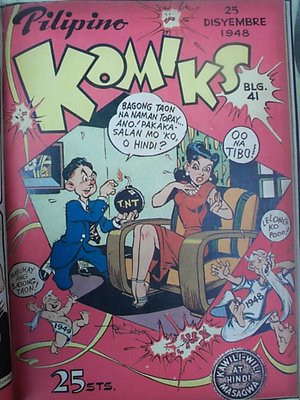
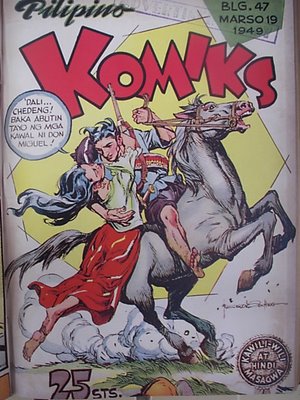
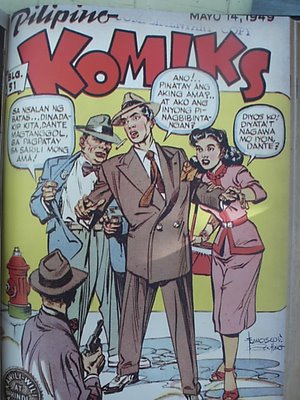
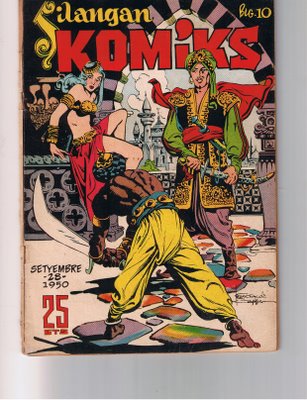

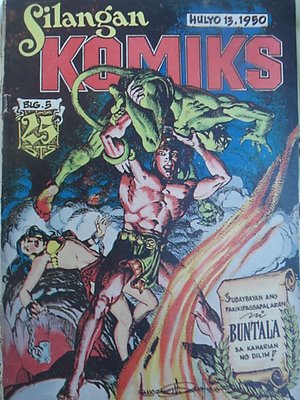
 Siopawman by Larry Alcala may be the first, albeit fumbling, Pinoy komiks superhero.
Siopawman by Larry Alcala may be the first, albeit fumbling, Pinoy komiks superhero. Ipo-Ipo, the very first true Pinoy superhero: how can you beat a superhero that you cannot hit?
Ipo-Ipo, the very first true Pinoy superhero: how can you beat a superhero that you cannot hit? Possibly influenced by Batman, Lagim even had a sidekick named Levy, whose costume was similar to Robin.
Possibly influenced by Batman, Lagim even had a sidekick named Levy, whose costume was similar to Robin. Yes, the original Darna was named Varga
Yes, the original Darna was named Varga
 Mang Mars with wife and kids. Circa 1960s.
Mang Mars with wife and kids. Circa 1960s.  A barefooted Mars Ravelo, with two of his children, walking towards his fish pens in Cavite. Circa 1960s.
A barefooted Mars Ravelo, with two of his children, walking towards his fish pens in Cavite. Circa 1960s.